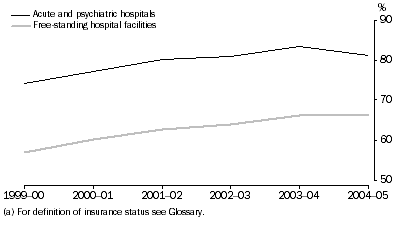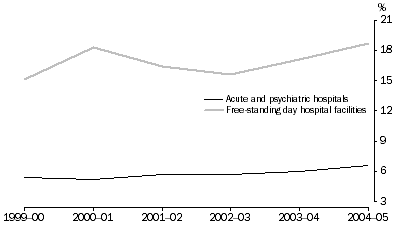This document was updated at 16:30 Friday 14 July following the main release at 11:30 am.
NOTES
ABOUT THIS PUBLICATION
This publication presents details from the 2004-05 national census of private hospitals. Three categories of hospitals are identified: acute hospitals, psychiatric hospitals and free-standing day hospital facilities.
There are relatively few psychiatric hospitals and some of these are owned by the same parent company. To maintain the confidentiality of their data, psychiatric hospitals are combined with acute hospitals in most tables in this publication. Any differences between the data presented in this publication and the data shown in other reports on private hospital activity are due to differences in scope and coverage, relative completeness of the data sources and differing error resolution procedures.
INQUIRIES
For further information about these and related statistics, contact the National Information and Referral Service on 1300 135 070 or on .
SUMMARY COMMENTARY
INTRODUCTION
This publication presents data for the private hospital sector in 2004-05. Comparable data for public hospitals are available in Australian Hospital Statistics 2004-05, produced by the Australian Institute of Health and Welfare (AIHW). According to this publication, about 4 in 10 hospital patients in Australia were admitted to private hospitals in 2004-05, representing 30% of all days of hospitalisation.
HOSPITALS
There were 532 private hospitals operating in Australia in 2004-05 compared with 525 in 2003-04. This represents an overall increase of 1.3% in the total number of private hospitals, reflecting an increase in free standing day hospitals (5.6%) and a decrease in acute and psychiatric hospitals (2.1%). The number of available beds and chairs decreased 0.6% from 26,589 in 2003-04 to 26,424 in 2004-05, again due to the decline of 1.2% in the number of beds and chairs in acute and psychiatric hospitals. Total patient separations increased by 3.3% (2.7m in 2003-04 to 2.8m in 2004-05). Private hospitals provided 7.3m days of hospitalisation to patients in 2004-05, much the same as for 2003-04. Staff numbers marginally decreased (0.1%) to 48,544 people (full-time equivalent).
PATIENT CHARACTERISTICS
Sex and Age
In 2004-05, the demographic profile of private hospital patients has changed very little from the previous year with females accounting for 55% of all patient separations, and people aged 65 and over accounting for 36% of all patient separations. Overall, there were 150 patient separations per 1,000 population for females and 124 patient separations per 1,000 population for males.
Insurance
The proportion of patient separations reported as being covered by hospital insurance decreased for all private hospitals. In 2004-05, 78% of patient separations reported having hospital insurance compared with 80% in 2003-04. Patient separations reported as being covered by hospital insurance in private acute and psychiatric hospitals decreased by 2.6% over the year, while for free-standing day hospitals there was a slight increase of 0.5%.
All Private Hospitals, Hospital insurance (a)

Procedures performed
The total number of procedures increased by 4.2% from 5.9 million in 2003-04 to 6.2 million in 2004-05. Of these procedures, 5.1 million were performed in acute and psychiatric hospitals and the remainder in free-standing day hospitals. The greatest proportion of procedures were non-invasive, cognitive and interventions nec (45%) followed by procedures on the digestive system (13%).
Examples of non-invasive and cognitive interventions are services such as dietary education and exercise therapy (often used for development of treatment plans, programs, case reviews or follow up to previous procedures performed). For further details of the classification refer to Volume 3 International Statistical Classification of Diseases and Related Health Problems, 10th Revision-Australian Modification (ICD-10-AM).
Similar patterns were reflected in both the acute and psychiatric and free-standing day hospitals.
For acute and psychiatric hospitals, non-invasive, cognitive and interventions, nec accounted for 46% of all procedures performed in 2004-05, up from 44% in the previous year. The next most common procedures in acute and psychiatric hospitals were on the digestive system (11%), the musculoskeletal system (6.6%) and procedures on the urinary system (4.5%).
For free-standing day hospitals, non-invasive, cognitive and interventions nec accounted for the highest proportion of all procedures performed on patients in 2004-05 at 40%. This is followed by procedures on the digestive system (22%), dermatological and plastic procedures (7.5%) and the eye and adnexa (8.1%).
The most common principle diagnosis for separations from all private hospitals was factors influencing health status and contact with health services (21%). This relates to occasions when circumstances other than a disease, injury or external cause are recorded as "diagnoses" or "problems" (see Glossary). The second most common priniciple diagnosis for separations was diseases of the digestive system (16%). Similarly in 2003-04, factors influencing health status and contact with health services represented 19% of patient separations and diseases of the digestive system represented 16% of patient separations.
Mode of Separation
The majority (97%) of all patients were discharged to their place of usual residence in 2004-05. Patient separations discharged to usual residence increased by 2.5% for private acute and psychiatric hospitals and 6.2% for free-standing day hospitals since 2003-04. For private acute and psychiatric hospitals, South Australia recorded the greatest increase (7.1%) followed by Western Australia (4.9%). These changes can be attributed to the overall increase in patient separations.
The number of patients discharged from a private acute and psychiatric hospital to other hospitals increased by 4.3% from 2003-04 to 2004-05. Queensland and Victoria increased transfers to other hospitals by 9.6% and 6.0% respectively, while New South Wales dropped by 1.7%.
INCOME & EXPENDITURE
Patient activity continued to grow with total income generated totalling $6,624m in 2004-05, up from $6,274m in 2003-04. Total income from private acute and psychiatric hospitals was $6,249m which accounted for 94% of all private hospital income.
Total recurrent expenditure for all private hospitals increased by 4.9% to $6,144m in 2004-05 from $5,859m in 2003-04. For private acute and psychiatric hospitals, the proportion of wages and salaries attributed to recurrent expenses remained steady at 51% in 2004-05, and for free-standing day hospitals was consistent with 2003-04 at 39%.
The private hospital sector invested $332m in building and other capital assets in 2004-05, with private acute and psychiatric hospitals increasing investment from $308.8m in 2003-04 to $309.3m in 2004-05. Free-standing day hospitals increased investment from $21.7m in 2003-04 to $22.4m in 2004-05.
NET OPERATING MARGIN
Net operating margin is derived by subtracting recurrent expenditure from income and expressing the result as a proportion of income. The net operating margin for acute and psychiatric hospitals during 2004-05 was 7.0%, up from 6.0% in 2003-04. The net operating margin for free-standing day hospital facilities was much higher at 19%, which was 17% higher than the previous year's percentage.
All Private Hospitals, Net Operating Margin

ACCREDITATION
Hospital accreditation has been identified as an indicator of capability within the National Health Performance Framework (for further information refer to Australian Hospitals 2003-04, produced by Australian Institute of Health and Welfare (AIHW)).
As at the 30 June 2005, the main organisations used by hospitals to obtain accreditation were Australian Council on Healthcare Standards (ACHS)(used by 386 hospitals) and Benchmark Certification (used by 58 hospitals).
 Print Page
Print Page
 Print All
Print All